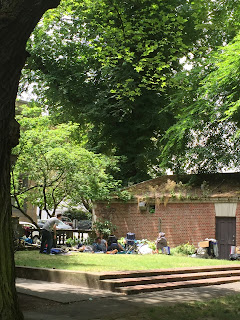Walking, I have learned, is conducive to the good life. Without fear of a DUI, I am becoming a connoisseur of craft cocktails, a nuanced art flourishing in Portland. For my daily needs, a hardware store, two markets, two drug stores, three grocery stores, and four parks are nearby. When crossing the river to east Portland, I favor a bicycle network that offers safe passage to a slate of vibrant pedestrian scaled neighborhoods and historic parks.
I have also given up television. Netflix and the PBS News Hour are available on my computer, but the city is more entertaining. With the automobile held at bay, the sidewalks and public realm are alive broadcasting a shifting blend of comedy, tragedy, and the quirky and mundane. People entertain themselves and each other. I realize I have traded the automobile and television for authenticity. I now pray to God that I will never see another car commercial, the American equivalent of Stalinist propaganda. In fact, when one appeared in a movie preview I blurted out “I’ve paid to see a movie not to be brainwashed by corporate hype." Humanity is rife here, and my outburst was just a minor note in the urban cacophony.
Although Portlanders are exceedingly polite, most evenings are broken by the discordant cries of the homeless, a reminder that a welcoming public realm is shared. I’ve learned to inure myself from the dispossessed, but not their lament. Their chords are so grating and visceral I have taken to reading Jean Paul Sartre. In a cold dark universe that is indifferent to humanity, anxiety is pervasive and only overcome, Sartre reasoned, by individuals taking action and creating meaning in their lives. “For the existentialist,” Sartre wrote, “there is no love other than that which is built.” There are 4,000 homeless in Portland losing the struggle to build love. Three in four suffer from mental illness and their cries express the anxiety we mask. http://www.oregonlive.com/opinion/index.ssf/2015/07/portland_homeless_crisis_easie.html
The city is a last refuge. This is why urban life has an edge. Helping the homeless is a test of our humanity, a challenge to bridge the abyss we wish to ignore.
Most nights I am delivered from feelings of existential dread. Watching the sun fade over the western hills and twilight slowly envelop the city in a hazy purple gray, peace envelops my thoughts. Often, I saunter to Tanner Springs and enjoy a spot of repose. On occasion I make a pilgrimage to Laurelhurst Park. There the interplay of shadow and light at evening’s end mimics a William Turner painting. It’s not a coincidence.
John Charles Olmsted, the noted landscape architect who proposed establishing Laurelhurst Park, studied Turner. Watching shifting shades of green play across a glen I revel in a transcendent moment. I well with gratitude, thankful that an earlier generation labored to lessen our anxiety. I am reminded of the words of John Ruskin, the polymath who championed Turner and urban reform, “the activity of our hope and labor will mark the time generations of men shall be confirmed for foundations of the gates of the city of God.” Hallelujah!
 |
| The La Fortezzea, Cibo on Division Street |
 |
| Urban Minstrel |
The city is a last refuge. This is why urban life has an edge. Helping the homeless is a test of our humanity, a challenge to bridge the abyss we wish to ignore.
 |
| Homeless in North Park Block |
John Charles Olmsted, the noted landscape architect who proposed establishing Laurelhurst Park, studied Turner. Watching shifting shades of green play across a glen I revel in a transcendent moment. I well with gratitude, thankful that an earlier generation labored to lessen our anxiety. I am reminded of the words of John Ruskin, the polymath who championed Turner and urban reform, “the activity of our hope and labor will mark the time generations of men shall be confirmed for foundations of the gates of the city of God.” Hallelujah!
 |
| Laurelhurst Park at Twilight |
No comments:
Post a Comment